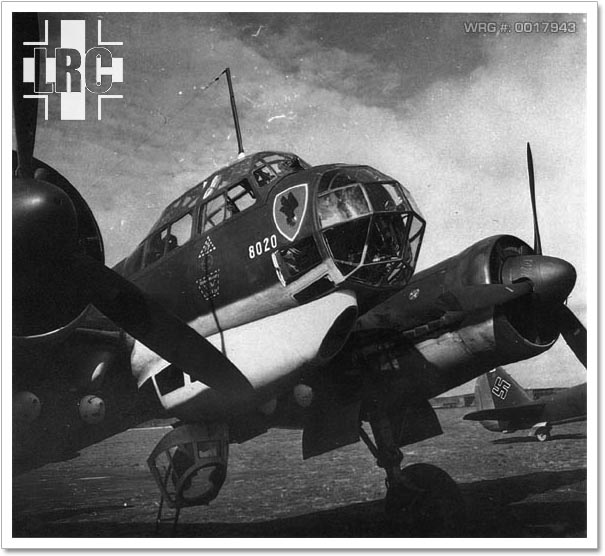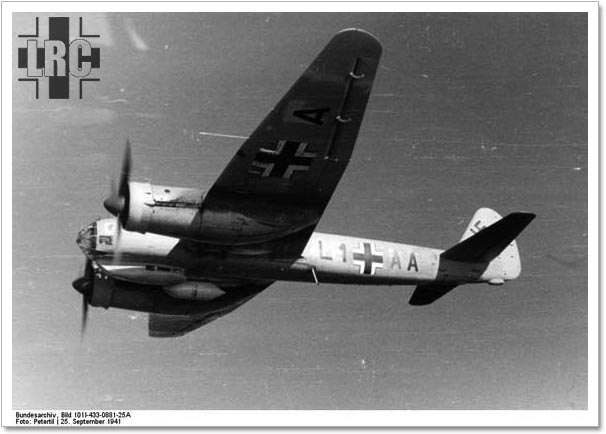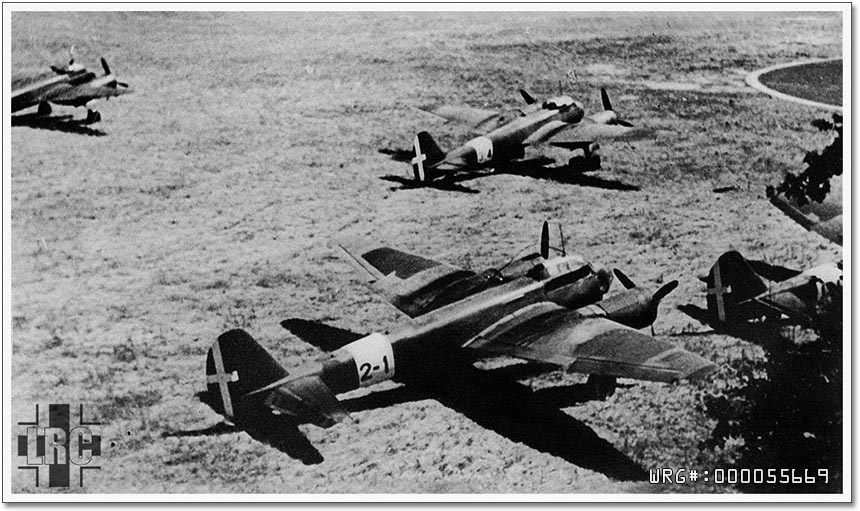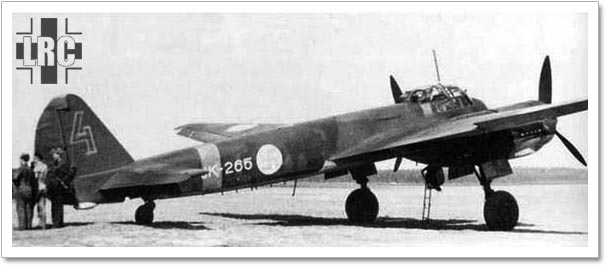Junkers Ju 88
Operational History
Polish Campaign
Only 12 Ju 88s saw action in Poland. The unit Erprobungskommando 88 (Ekdo 88) was responsible for testing new bomber designs and their crews under hostile conditions. They selected 12 aicraft and their crews and attached them to 1./Kampfgeschwader 25. As a result of its small operational numbers, the type made no impact.Battle of Norway
The Luftwaffe committed II./Kampfgeschwader 30 to the campaign under X. Fliegerkorps for Operation Weserübung. The unit was equipped with Ju 88s and engaged Allied shipping as its main target. On 9 April 1940, Ju 88s of KG 30 dive-bombed, in cooperation with high-level bombing Heinkel He 111s of KG 26, and helped damage the battleship HMS Rodney and sink the destroyer HMS Gurkha. However, the unit lost four Ju 88s in the action, the highest single loss of the aircraft in combat throughout the campaign.Battle of France
The Luftwaffe's order of battle for the French campaign reveals all but one of the Luftwaffe's Fliegerkorps (I. Fliegerkorps) contained Ju 88s in the combat role. The mixed bomber units, including the Ju 88, of Kampfgeschwader 51 (under the command of Luftflotte 3) helped claim between 233 and 248 Allied aircraft on the ground between 10-13 May 1940. The Ju 88 was particularly effective at dive-bombing. Between 13-24 May, I. and II./KG 54 flew 174 attack against rail systems, paralysing French logistics and mobility. On 17 June 1940, Junkers Ju 88s (mainly from Kampfgeschwader 30) destroyed a "10,000 tonne ship", the 16,243 grt ocean liner RMS Lancastria, off Saint-Nazaire, killing some 5,800 Allied personnel.
Junkers Ju 88A-5 (WNr 8020) of KG 30, France 1940.
[Source: unknown]
Battle of Britain
By August 1940, A-1s and A-5s were reaching operational units, just as the battle was intensifying. The Battle of Britain proved very costly. Its faster speed did not prevent Ju 88 losses exceeding those of its Dornier Do 17 and Heinkel He 111 stablemates, despite being deployed in smaller numbers than either. Ju 88 losses over Britain in 1940 amounted to 313 machines between July-October 1940. One notable incident involved ground fighting between the crew of an A-1 and soldiers from the London Irish Rifles during the Battle of Graveney Marsh on 27 September 1940. It was the last action between British and foreign military forces on British mainland soil. Do 17 and He 111 losses for the same period amounted to 132 and 252 machines destroyed respectively. A series of field kits were made to make it less vulnerable, including the replacement of the rear machine gun by a twin-barreled machine gun, and additional cockpit armour. It was during the closing days of the Battle of Britain that the flagship Ju 88 A-4 went into service. Although slower yet than the A-1, nearly all of the troubles of the A-1 were gone, and finally the Ju 88 matured into a superb warplane. The A-4 actually saw additional improvements including more powerful engines, but, unlike other aircraft in the Luftwaffe, did not see a model code change. The Ju 88 C-series also benefited from the A-4 changes, and when the Luftwaffe finally did decide on a new heavy fighter, the Ju 88C was a powerful, refined aircraft.Eastern Front
By summer 1941, most of the units equipped with the Dornier Do 17 were upgrading to the Ju 88. With a few exceptions, most of the German bomber units were now flying the He 111 and Ju 88. The Ju 88 was to prove a very capable and valuable asset to the Luftwaffe in the east. The Ju 88 units met with instant success, attacking enemy airfields and positions at low level and causing enormous losses for little damage in return. 3./Kampfgeschwader 3 attacked Pinsk airfield in the morning of the 22 June 1941. It caught, and claimed destroyed, 60 Soviet bombers on the ground. The 39 SBAP Regiment of the 10 Division SAD actually lost 43 Tupolev SBa and five Petlyakov Pe-2s. Ju 88s from Kampfgeschwader 51 destroyed over 100 aircraft after dispatching 80 Ju 88s to hit airfields. In general the Soviet aircraft were not dispersed and the Luftwaffe found them easy targets. A report from the Soviet 23rd Tank Division of the 12th Armoured Corps reported a low-level attack by Ju 88s on 22 June, resulting in the loss of 40 tanks. However, the Ju 88s were to suffer steady attritional losses. At 0415 on 22 June 1941, III./KG 51 attacked the airfield at Kurovitsa. Despite destroying 34 Polikarpov I-153s, the Ju 88s were intercepted by 66 ShAP I-153s. Six Ju 88s were shot down before the German fighter escort dealt with the threat. By the end of the first day of the campaign, Ju 88 losses amounted to 23 destroyed.
Ju 88A of LG 1 over the Eastern Front, 25 September 1941.
[Source: unknown]
Italian Campaign
On 2 December 1943, 105 Ju 88 A-4s, armed with bombs and motobomba circling torpedoes, attacked the Allied-held port of Bari, Italy. The attacking force achieved complete surprise and sunk over 20 Allied ships in the overcrowded harbour, including the U.S. Liberty ship John Harvey, which was carrying mustard gas. About 1,000 people were killed and another 1,000 wounded; many fatalities and injuries were as a result of the release of mustard gas. The attacking force lost one aircraft; the Allies had not assigned any fighters to guard Bari as they thought the Luftwaffe incapable of striking in this strength at this stage of the war. The port was completely closed for three weeks from the damage of the raid, and only resumed full operation in February 1944.
Regia Aeronautica Junkers Ju 88A/2-1 of 2 Squadriglia, Italy 1943.
[Source: www.asisbiz.com]
Finnish Air Force
In April 1943, as Finland was fighting its Continuation War against the USSR, the Finnish Air Force bought 24 Ju 88s from Germany. The aircraft were used to equip No. 44 Sqn, which had previously operated Bristol Blenheims, but these were instead transferred to No. 42 Sqn. Due to the complexity of the Ju 88, the Luftwaffe spent most of 1943 training crews on the aircraft, and conducted only a handful of bombing missions. The most notable was a raid on the Lehto partisan village on 20 August 1943 (in which the whole squadron participated), and a raid on the Lavansaari air field (leaving seven Ju 88 damaged from forced landing in inclement weather). In the summer of 1943, the Finns noted stress damage on the wings. This had occurred when the aircraft were used in dive bombing. Restrictions followed: the dive brakes were removed and it was only allowed to dive at a 45-degree angle (compared to 60–80 degrees previously). In this way, they tried to spare the aircraft from unnecessary wear.
Finnish Air Force Junkers Ju 88 A-4.
[Source: unknown]
Sources:
Gunston, Bill - The Encyclodepia of the Worlds Combat aircraft, 1976, Chartwell Books, Inc., New York
Brown, Eric, Captain - Wings of the Luftwaffe , 1979, Airlife Publishing Ltd., Shrewsbury
, 1979, Airlife Publishing Ltd., Shrewsbury
Gunston, Bill & Wood, Tony - Hitler's Luftwaffe , 1977, Salamander
Books Ltd., London
, 1977, Salamander
Books Ltd., London
Donald, David - The Complete Encyclopedia Of World Aircraft, 1997, Brown Packaging Books Ltd., London
Wikipedia - Junkers Ju 88
Gunston, Bill - The Encyclodepia of the Worlds Combat aircraft, 1976, Chartwell Books, Inc., New York
Brown, Eric, Captain - Wings of the Luftwaffe
Gunston, Bill & Wood, Tony - Hitler's Luftwaffe
Donald, David - The Complete Encyclopedia Of World Aircraft, 1997, Brown Packaging Books Ltd., London
Wikipedia - Junkers Ju 88






